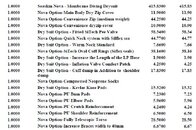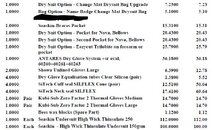Efka76
Contributor
I did quite a lot of trainings with PADI and TDI. After moving to Edinburgh I wanted to dive here as well. However, I was a bit afraid of cold water as it did not know how my bold head will react to really cold water 
So, I decided to try diving with drysuit first. I enrolled into PADI Dry suit diving course and had 1 training in confined water (pool) and 2 dives in open water. I was very surprised that I was feeling very comfortable in +11C water. It seems that even simple hood and drysuit protects body very well. Visibility during dives was not great (5-8 m) but it was really nice to get new skills and dive in Scottish waters.
After this I ordered a new drysuit and enrolled to local BSAC club. When my suits arrives (unfortunately this will happen at the end of October) I will do crossover to BSAC Sports diver. I understand that it will be pretty easy crossover as I already have all required pre-recquisites as welll as familiar with various types of diving and decompression diving as well.
Selecting drysuit is a pretty hard task. There is a big variety, many manufacturers and really different price ranges. Santi, Otter, etc. seem very good and reliable drysuits, however, I did not want to spend a lot of money. These models including undergarments and base layers would cost more than £ 2,600. After long considerations I decided to go with made-to-measure Seaskin Nova Drysuit. I choose these options:
1) Main body dry zip cover - for protection of expensive dry zip
2) Quick neck system with Silflex sea - neck seal can be replaced by diver itself.
3) Warm neck - self explanatory
4) Upgrade for neck and hands silicon seals;
5) Kubi fitted dry cuff system - this is the most expensive option in this drysuit, which cots over £ 200, however, by reading various reviews I hope that it will be ueseful (especially in diving in +5C temp water);
6) option to move dump valve on shoulder
7) Si-tech valve system - I think Apeks is ok as well but did this upgrade
8) Increased length of LP hose - I am quite big and wanted to have some flexibility;
9) Compressed neoprene socks - I really liked diving with neoprene socks; also, I like that it will be possible to turn drysuit out and properly dry it, if there is a need. WIth installed boots you can not do that.
10) Aqualung rock boots EVO 4 - sometimes I will need to access shore dive sites by foot and will need to go through sharp rocks. These boots is really good option for such dives.
11) Kevlar knee pads, bum pads, elbow pads, crutch reinforcement, shoulder reinforcement - additional suit protection will be handy.
12) Telescopic torso option
13) Reflective tapes on hands, glow patches - additional vizibility in underwater is good as well.
14) Drysuit bag upgrade to dive mat - very useful as I will not need to carry additional stuff.
15) 2 Big pockets on legs
16) Eazycut Trylobite, installed on forearm.
17) Kubi gloves
18) Seaskin made-to-measure 5 mm hood.
19) Spare parts (neck and hands silicone seals)
I also choose Sea skin high wick Thinsulate 250 undersuit as well as Sea skin base layer (pants and top). All these goods cost me £ 1,386. According to my calculations I saved more than £ 1,000. I really hope that my new drysuit will be good and will ensure dry diving for many years.
When I get my merchandise and dive few times I will post my impressions about quality of Seaskin drysuit.
So, I decided to try diving with drysuit first. I enrolled into PADI Dry suit diving course and had 1 training in confined water (pool) and 2 dives in open water. I was very surprised that I was feeling very comfortable in +11C water. It seems that even simple hood and drysuit protects body very well. Visibility during dives was not great (5-8 m) but it was really nice to get new skills and dive in Scottish waters.
After this I ordered a new drysuit and enrolled to local BSAC club. When my suits arrives (unfortunately this will happen at the end of October) I will do crossover to BSAC Sports diver. I understand that it will be pretty easy crossover as I already have all required pre-recquisites as welll as familiar with various types of diving and decompression diving as well.
Selecting drysuit is a pretty hard task. There is a big variety, many manufacturers and really different price ranges. Santi, Otter, etc. seem very good and reliable drysuits, however, I did not want to spend a lot of money. These models including undergarments and base layers would cost more than £ 2,600. After long considerations I decided to go with made-to-measure Seaskin Nova Drysuit. I choose these options:
1) Main body dry zip cover - for protection of expensive dry zip
2) Quick neck system with Silflex sea - neck seal can be replaced by diver itself.
3) Warm neck - self explanatory
4) Upgrade for neck and hands silicon seals;
5) Kubi fitted dry cuff system - this is the most expensive option in this drysuit, which cots over £ 200, however, by reading various reviews I hope that it will be ueseful (especially in diving in +5C temp water);
6) option to move dump valve on shoulder
7) Si-tech valve system - I think Apeks is ok as well but did this upgrade
8) Increased length of LP hose - I am quite big and wanted to have some flexibility;
9) Compressed neoprene socks - I really liked diving with neoprene socks; also, I like that it will be possible to turn drysuit out and properly dry it, if there is a need. WIth installed boots you can not do that.
10) Aqualung rock boots EVO 4 - sometimes I will need to access shore dive sites by foot and will need to go through sharp rocks. These boots is really good option for such dives.
11) Kevlar knee pads, bum pads, elbow pads, crutch reinforcement, shoulder reinforcement - additional suit protection will be handy.
12) Telescopic torso option
13) Reflective tapes on hands, glow patches - additional vizibility in underwater is good as well.
14) Drysuit bag upgrade to dive mat - very useful as I will not need to carry additional stuff.
15) 2 Big pockets on legs
16) Eazycut Trylobite, installed on forearm.
17) Kubi gloves
18) Seaskin made-to-measure 5 mm hood.
19) Spare parts (neck and hands silicone seals)
I also choose Sea skin high wick Thinsulate 250 undersuit as well as Sea skin base layer (pants and top). All these goods cost me £ 1,386. According to my calculations I saved more than £ 1,000. I really hope that my new drysuit will be good and will ensure dry diving for many years.
When I get my merchandise and dive few times I will post my impressions about quality of Seaskin drysuit.






